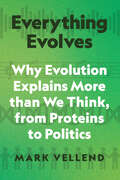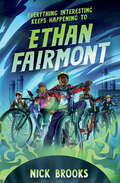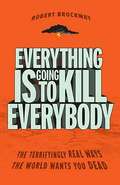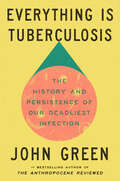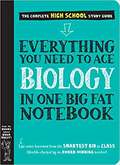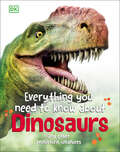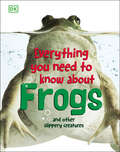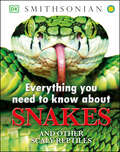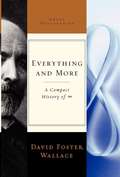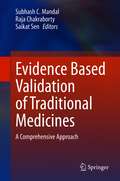- Table View
- List View
Everything Awesome About: Dangerous Dinosaurs (Everything Awesome About)
by Mike LoweryLearn everything that's AWESOME about dinosaurs, in this nonfiction Reader that combines cartoon illustrations and photographs!Do you know which dinosaur has the most horns? Or which dinosaur has a clubbed tail that could break a T. Rex's bones? It's time to meet... the DANGEROUS DINOSAURS!Find out all this and more, in Everything Awesome About: Dangerous Dinosaurs, a one-stop shop for the dinosaur-obsessed kid who wants to start reading on their own! With a highly visual approach that mixes kid-friendly cartoons and engaging photographs, this Reader packs in the facts and is sure to become a quick favorite for dinosaur fans.Learn the top facts about your favorite dinosaurs, from dangerous predators to gentle giants.This Level 3 Reader is perfect for kids who are starting to read on their own, and want to build reading confidence and develop vocabulary skills while learning cool facts about their favorite beasts.Be sure to check out more in this series, with Everything Awesome About: Super Sharks!
Everything Evolves: Why Evolution Explains More than We Think, from Proteins to Politics
by Mark VellendHow the science of evolution explains how everything came to be, from bacteria and blue whales to cell phones, cities, and artificial intelligenceEverything Evolves reveals how evolutionary dynamics shape the world as we know it and how we are harnessing the principles of evolution in pursuit of many goals, such as increasing the global food supply and creating artificial intelligence capable of evolving its own solutions to thorny problems.Taking readers on an astonishing journey, Mark Vellend describes how all observable phenomena in the universe can be understood through two sciences. The first is physics. The second is the science of evolvable systems. Vellend shows how this Second Science unifies biology and culture and how evolution gives rise to everything from viruses and giraffes to nation-states, technology, and us. He discusses how the idea of evolution had precedents in areas such as language and economics long before it was made famous by Darwin, and how only by freeing ourselves of the notion that the study of evolution must start with biology can we appreciate the true breadth of evolutionary processes.A sweeping tour of the natural and social sciences, Everything Evolves is an essential introduction to one of the two key pillars to the scientific enterprise and an indispensable guide to understanding some of the most difficult challenges of the Anthropocene.
Everything Has a History (Routledge Revivals)
by J. B. HaldaneIn this collection, first published in 1951, the central theme is that everything has a history, and that we cannot fully understand anything without some knowledge of its history. Professor Haldane writes mainly on geology, astronomy and zoology, but includes a variety of other topics, including eugenics, Einstein, and C. S. Lewis. His outlines of zoology, of the geology of England, and of the evidence for astronomical theories, will be of great use to students and teachers.
Everything Interesting Keeps Happening to Ethan Fairmont (Ethan Fairmont)
by Nick BrooksNick Brooks, award-winning filmmaker and acclaimed author of Promise Boys, presents the thrilling conclusion to the Ethan Fairmont trilogy in which Cheese the alien returns to Earth to warn Ethan and his friends of an impending alien invasion. Before last summer, Ethan&’s life was rather uninteresting. Now, Ethan can&’t stop interesting things from happening . . . After a small, six-eyed alien crash landed into his life, Ethan made a new otherworldly best friend. Now Cheese has returned to Earth, bringing his family and a warning of the Light Thieves&’ plans to invade. Ethan is already reeling from the kidnapping of his beloved guinea pig, Nugget, and a dangerous reality sets in after one bold Light Thief sheds its disguise to attack Ethan on his front lawn. Ethan needs his friends now more than ever, but as he and RJ continue to clash, tensions continue to rise within the group. On top of all that, he still hasn&’t figured out how to deal with his feelings for Di. With an alien invasion on the horizon, and The Bureau for Weird Happenings indisposed, can Ethan and his friends work together to save Earth once and for all?E.T. meets Stranger Things in the final chapter of this remarkable middle grade sci-fi adventure series, perfect for readers ages 8 to 12.
Everything Is Going to Kill Everybody: The Terrifyingly Real Ways the World Wants You Dead
by Robert BrockwayJust when you thought you’d accepted your own mortality . . . Everything Is Going to Kill Everybodyis bringing panic back. Twenty illustrated, hilariously fear-inducing essays reveal the chilling andvery realexperiments, dangerous emerging technologies, and terrifying natural disasters that soon could-or very nearly already did-bring about the end of humanity. In short, everything in here will kill you and everyone you love. At any moment. And nobody’s told you about it-until now: " Experiments in green energy like the HiPER, which uses massive lasers to create a tiny “contained” sun; it’s an idea that could save the world if it doesn’t consume us all in a fiery fusion reaction first. " Global disasters like the hypercane-a hurricane so large it could cover all of North America and shoot trailer parks into space! " Terrifying new developments in robotics like the EATR, which powers itself on meat-an invention in the running for “Worst Decision Made by Anybody. ”
Everything Is Matter
by David BauerIn this book children are introduced to the concept of matter, its three forms, and how one form can change into another.
Everything Is Predictable: How Bayes' Remarkable Theorem Explains the World
by Tom ChiversThomas Bayes was an eighteenth-century Presbyterian minister and amateur mathematician whose obscure life belied the profound impact of his work. Like most research into probability at the time, his theorem was mainly seen as relevant to games of chance, like dice and cards. But its implications soon became clear. Bayes' theorem helps explain why highly accurate screening tests can lead to false positives, causing unnecessary anxiety for patients. A failure to account for it in court has put innocent people in jail. But its influence goes far beyond practical applications. A cornerstone of rational thought, Bayesian principles are used in modelling and forecasting. 'Superforecasters', a group of expert predictors who outperform CIA analysts, use a Bayesian approach. And many argue that Bayes' theorem is not just a useful tool, but a description of almost everything - that it is the underlying architecture of rationality, and of the human brain. Fusing biography, razor-sharp science communication and intellectual history, Everything Is Predictable is a captivating tour of Bayes' theorem and its impact on modern life. From medical testing to artificial intelligence, Tom Chivers shows how a single compelling idea can have far-reaching consequences.
Everything Is Tuberculosis: The History and Persistence of Our Deadliest Infection
by John GreenJohn Green, the #1 bestselling author of The Anthropocene Reviewed and a passionate advocate for global healthcare reform, tells a deeply human story illuminating the fight against the world’s deadliest infectious disease. <p> “This highly readable call to action could not be more timely.” –Kirkus, starred review. <p> “Memorably probes the intersections of medicine and human emotion.” –Bookpage, starred review. <p> Tuberculosis has been entwined with humanity for millennia. Once romanticized as a malady of poets, today tuberculosis is seen as a disease of poverty that walks the trails of injustice and inequity we blazed for it. In 2019, author John Green met Henry Reider, a young tuberculosis patient at Lakka Government Hospital in Sierra Leone. John became fast friends with Henry, a boy with spindly legs and a big, goofy smile. In the years since that first visit to Lakka, Green has become a vocal advocate for increased access to treatment and wider awareness of the healthcare inequities that allow this curable, preventable infectious disease to also be the deadliest, killing over a million people every year. <p> In Everything Is Tuberculosis, John tells Henry’s story, woven through with the scientific and social histories of how tuberculosis has shaped our world—and how our choices will shape the future of tuberculosis. <b>New York Times Bestseller</b>
Everything You Need To Ace Biology In One Big Fat Notebook (Big Fat Notebook)
by Matthew Brown Workman PublishingThis Big Fat Notebook covers everything you need to know during a year of high school BIOLOGY class, breaking down one big bad subject into accessible units. Including: biological classification, cell theory, photosynthesis, bacteria, viruses, mold, fungi, the human body, plant and animal reproduction, DNA & RNA, evolution, genetic engineering, the ecosystem and more. Study better with mnemonic devices, definitions, diagrams, educational doodles, and quizzes to recap it all.
Everything You Need to Ace Biology in One Big Fat Notebook (Big Fat Notebooks)
by Matthew Brown Workman PublishingThe Big Fat Notebooks go to high school! This study guide for high school Biology introduces students to all the big ideas in the course, with clear diagrams, fun doodles, clever mnemonics, and other ways to understand and remember what you need to ace this challenging course.
Everything You Need to Ace Science in One Big Fat Notebook: The Complete Middle School Study Guide
by Workman PublishingIt’s the revolutionary science study guide just for middle school students from the brains behind Brain Quest. Everything You Need to Ace Science takes readers from scientific investigation and the engineering design process to the Periodic Table; forces and motion; forms of energy; outer space and the solar system; to earth sciences, biology, body systems, ecology, and more.
Everything You Need to Know About Acne (Need to Know Library)
by Jennifer CeaserDescribes the different types of acne, their causes, treatment, and prevention.
Everything You Need to Know About Dinosaurs: And Other Prehistoric Creatures (Everything You Need to Know)
by DKA fun, fact-filled dive into the world of dinosaurs for kids-packed full of brilliant images.All the basics of these amazing creatures are covered in this beautiful and informative book on dinosaurs. Anatomy, along with habitat and behavior, and lots of fascinating facts about dinosaurs that every child will just love reading about. See how they survived all over the world, and how these prehistoric creatures adapted to their ancient habitats. Alongside, in between, and on top of all that, Everything You Need to Know About Dinosaurs also provides ideas for things to make, games to play, quizzes, and amazing facts to share with friends. Every spread is self-contained to make this a dip-into book with a difference. From the very first page it combines little-known information with engaging text and innovative, high-quality design.It's everything you need to know, and everything you want to find out.
Everything You Need to Know About Frogs and Other Slippery Creatures (Everything You Need to Know)
by DKDiscover the amazing world of our cold-blooded friends in this book all about frogs and amphibians for kids.Embark on a fun, fact-filled dive into the world of frogs and amphibians with Everything You Need to Know About Frogs. Children will love to learn all the basics of reptile and amphibian anatomy in this beautiful and informative book on frogs.Packed with vibrant pictures and lots of fascinating facts, kids can enjoy learning all about a frog&’s habitat and behavior. Discover how these amphibians survive in lakes and rivers, forests and deserts, and how these clever creatures have adapted to live in seemingly inhospitable habitats. Alongside, in between, and on top of all that, this riveting frog book also provides ideas for things to make, games to play, quizzes, and amazing facts to share with friends!Inside the pages of this frog book for children, you&’ll find: A whole host of amphibians and reptiles including toads, snakes, lizards, salamanders, turtles, newts, tortoises and crocodiles.Close-ups, quizzes, and games with an exciting take on the amazing world of our cold-blooded friends.A look at these creatures from all angles – information on habitat and breeding habits, as well as oddities such as how to survive a crocodile&’s attack, how a frog&’s legs influenced Frankenstein, or how to play snakes and ladders.Children aged 7+ can learn all about frogs and amphibians from the very first page of this book, which combines little-known information with engaging text and an exciting design. Each page contains everything kids need to know, and everything they WANT to find out about frogs!. Complete the seriesThis delightful frog book is part of the Everything You Need to Know series of educational books for children and also includes Everything You Need to Know About Snakes and Everything You Need to Know About Dinosaurs!
Everything You Need to Know About Snakes (Everything You Need to Know)
by John Woodward DKDiscover the amazing world of reptiles in this book all about snakes for kids.Embark on a fun, fact-filled dive into the world of snakes with Everything You Need to Know About Snakes. Children will love to learn all the basics of reptile anatomy in this beautiful and informative book on our serpent friends.Packed with vibrant pictures and lots of fascinating facts, kids can enjoy learning all about a snake&’s habitat and behavior. See how they survive in forests, deserts, and oceans, and how these clever creatures have adapted to live in seemingly inhospitable habitats. Alongside, in between, and on top of all that, this riveting snake book also provides ideas for things to make, games to play, quizzes, and amazing facts to share with friends!Inside the pages of this reptile book for children, you&’ll find:- Facts on habitat and anatomy, as well as oddities such as why snakes have scales and why chameleons change color.-Close-ups, quizzes, and games with an exciting take on the amazing world of our cold-blooded friends.-A look at these creatures from all angles – information on habitat and breeding habits, as well as information on pythons, Komodo dragons, sea turtles, and many more.Children aged 7+ can learn all about snakes from the very first page of this book, which combines little-known information with engaging text and an exciting design. Each page contains everything kids need to know, and everything they WANT to find out about snakes!Complete the seriesThis delightful snake book is part of the Everything You Need to Know series of educational books for children and also includes Everything You Need to Know About Frogs and Everything You Need to Know About Dinosaurs!
Everything You Need to Know about Dinosaurs (Everything You Need to Know)
by John Woodward DKDiscover the amazing world of prehistoric reptiles in this book all about dinosaurs for kids.Embark on a fun, fact-filled dive into the prehistoric world with Everything You Need to Know About Dinosaurs. Children will love going back in time and learning about these cold-blooded creatures.Packed with vibrant pictures and lots of fascinating facts, kids can enjoy learning about how dinosaurs survived all over the world and how they adapted to their ancient habitats. Discover the anatomy, habitat and behavior of these prehistoric creatures through fascinating facts that children aged 7+ will love reading about. Alongside, in between, and on top of all that, this riveting dinosaur book also provides ideas for things to make, games to play, quizzes, and amazing facts to share with friends!This dinosaur book for children offers:- An introduction to a whole host of dinosaurs including Stegosaurus, Velociraptor, Pterodactylus and the mighty Tyrannosaurus rex.- Close-ups, quizzes, and games with an exciting take on the amazing world of our cold-blooded friends.- A look at these creatures from all angles – information on habitat and breeding habits, as well as oddities such as which dinosaurs would win in a race, why some dinosaurs were &“boneheads&”, and how scientists uncover the colors of dinosaur feathers. Children aged 7+ can learn all about prehistoric creatures from the very first page of this book, which combines little-known information with engaging text and an exciting design. Each page contains everything kids need to know, and everything they WANT to find out about dinosaurs!Complete the SeriesThis delightful dinosaur book is part of the Everything You Need to Know series of educational books for children and also includes Everything You Need to Know About Snakes and Everything You Need to Know About Frogs!
Everything and More: A Compact History of Infinity
by David Foster WallaceDavid Wallace brings his intellectual ambition to the story of how mathematicians have understood the infinite, from the ancient Greeks to the nineteenth-century mathematical genius Cantor's discovery that there is more than one kind of infinity.
Everything in Its Place: First Loves and Last Tales
by Oliver SacksFrom the bestselling author of Gratitude and On the Move, a final volume of essays that showcases Sacks's broad range of interests--from his passions for ferns, swimming, and horsetails, to his final case histories exploring schizophrenia, dementia, and Alzheimer's.Oliver Sacks, renowned scientist and storyteller, is adored by readers for his neurological case histories, his fascination and familiarity with human behaviour at its most unexpected and unfamiliar. Everything in Its Place is a celebration of Sacks's myriad interests, all told with his characteristic compassion, erudition, and luminous prose. From the celebrated case history of Spalding Gray that appeared in The New Yorker four months before his death to reflections on mental asylums; from piercing accounts of Schizophrenia to a reminiscence of Robin Williams; from the riveting tale of a medical colleague falling victim to Alzheimer's to the cinematography of Michael Powell, this volume celebrates and reflects the wondrous curiosity of Oliver Sacks.
Everything in Its Place: First Loves and Last Tales
by Oliver SacksFrom the legendary author of The Man Who Mistook His Wife for a Hat: a volume of essays on everything from primordial life and the mysteries of the brain to the ancient ginkgo and the power of the written word. "Magical . . . [Everything in Its Place] showcases the neurologist's infinitely curious mind."—People MagazineIn this volume, Oliver Sacks examines the many passions that defined his life--both as a doctor engaged with the central questions of human existence and as a polymath conversant in all the sciences. Everything in Its Place brings together writings on a rich variety of topics. Why do humans need gardens? How, and when, does a physician tell his patient she has Alzheimer's? What is social media doing to our brains? In several of the compassionate case histories included here, we see Sacks consider the enigmas of depression, psychosis, and schizophrenia for the first time. In others, he returns to conditions that have long fascinated him: Tourette's syndrome, aging, dementia, and hallucinations. In counterpoint to these elegant investigations of what makes us human, this volume also includes pieces that celebrate Sacks's love of the natural world--and his final meditations on life in the twenty-first century.
Everything is Now: Revolutionary Ideas from String Theory
by Bill SpenceThis engaging and beautifully written book gives an authoritative but accessible account of some of the most exciting and unexpected recent developments in theoretical physics. – Professor Lionel J Mason, Mathematical Institute, University of Oxford String theory is often paraded as a theory of everything, but there are a large number of untold stories in which string theory gives us insight into other areas of physics. Here, Bill Spence does an excellent job of explaining the deep connections between string theory, particle physics, and the novel way of viewing space and time. – Professor David Tong, Department of Applied Mathematics and Theoretical Physics, University of Cambridge Foremost amongst Nature’s closest-guarded secrets is how to unite Einstein’s theory of gravity with quantum theory – thereby creating a ‘quantum space-time’. This problem has been unsolved now for more than a century, with the standard methods of physics making little headway. It is clear that much more radical ideas are needed, and our front-line researchers are showing that string theory provides these. This book describes these extraordinary developments, which are helping us to think in entirely new ways about how physical reality may be structured at its deepest level. Amongst these ideas are that Everything can happen at the same time – it is all Now; Hidden spaces, large and small, are everywhere amongst us; The basic objects are ‘membranes’ that behave like soap bubbles and can explore the shape of spacetime in new ways; We are holographic projections from higher dimensions; You can take the ‘square root’ of gravity; Ideas from the ancient Greeks are resurfacing in a beautiful new form; And the very latest work shows that ‘staying positive’ is essential. The book is aimed at a general audience, using analogies, diagrams, and simple examples throughout. It is intended as a brief tour, enabling the reader to become aware of the main ideas and recent work. A full list of further resources is supplied. Bill Spence is the founding Director of the Centre for Research in String Theory at Queen Mary University of London. He has worked on string theory for over three decades.
Evidence
by Lucy SanteFollowing Low Life, Lucy Sante's acclaimed evocation of the underside of New York City's history, Evidence is an investigation into the mysteries of crime, death, and photography that only this brilliant and original writer could conduct.In one sense Evidence is a picture book - a collection of 55 evidence photographs taken by the New York City Police Department between 1914 and 1918. These are startling images, some brutal, some poetic, and all possessed of a strange and spectral beauty.Lucy Sante minutely examines these pictures of crime scenes and draws them out by every possible means: speculating about the lives and deaths depicted; discussing the progress of the forensic use of photographs and the mission of photography itself; and, where possible, reconstructing the events that led up to these frozen terminal images. Evidence is many things at once: aesthetic object, historical and sociological document, mystery novel, memento mori, and time machine.
Evidence Based Physical Therapy
by Linda Fetters Julie TilsonImprove outcomes through evidence-based therapy. This practical, easy-to-use guide uses a five-step process to show you how to find, appraise, and apply the research in the literature to meet your patient’s goals. You'll learn how to develop evidence-based questions specific to your clinical decisions and conduct efficient and effective searches of print and online sources to identify the most relevant and highest quality evidence. Then, you'll undertake a careful appraisal of the information; interpret the research; and synthesize the results to generate valid answers to your questions. And, finally, you'll use the Critically Appraised Topic (CAT) tool to communicate your findings.
Evidence Based Validation of Traditional Medicines: A comprehensive Approach
by Saikat Sen Raja Chakraborty Subhash C. MandalThe demand for traditional medicines, herbal health products, herbal pharmaceuticals, nutraceuticals, food supplements and herbal cosmetics etc. is increasing globally due to the growing recognition of these products as mainly non-toxic, having lesser side effects, better compatibility with physiological flora, and availability at affordable prices. In the last century, medical science has made incredible advances all over the globe. In spite of global reorganization and a very sound history of traditional uses, the promotion of traditional medicine faces a number of challenges around the globe, primarily in developed nations. Regulation and safety is the high concern for the promotion of traditional medicine. Quality issues and quality control, pharmacogivilane, scientific investigation and validation, intellectual property rights, and biopiracy are some key issues that restrain the advancement of traditional medicine around the globe. This book contains diverse and unique chapters, explaining in detail various subsections like phytomolecule, drug discovery and modern techniques, standardization and validation of traditional medicine, and medicinal plants, safety and regulatory issue of traditional medicine, pharmaceutical excipients from nature, plants for future. The contents of the book will be useful for the academicians, researchers and people working in the area of traditional medicine.
Evidence Contestation: Dealing with Dissent in Knowledge Societies (Routledge Studies in the Philosophy of Science)
by Mariacarla Gadebusch Bondio Karin Zachmann Saana Jukola Olga SparschuhThis book examines the practices of contesting evidence in democratically constituted knowledge societies. It provides a multifaceted view of the processes and conditions of evidence criticism and how they determine the dynamics of de- and re-stabilization of evidence. Evidence is an essential resource for establishing claims of validity, resolving conflicts, and legitimizing decisions. In recent times, however, evidence is being contested with increasing frequency. Such contestations vary in form and severity—from questioning the interpretation of data or the methodological soundness of studies to accusations of evidence fabrication. The contributors to this volume explore which actors, for what reasons and to what effect, question evidence in fields such as the biological, environmental, and health sciences. In addition to actors inside academia, they examine the roles of various other actors, including citizen scientists, counter-experts, journalists, patients, consumers, and activists. The contributors tackle questions of how disagreements are framed and how they are used to promote vested interests. By drawing on methodological and theoretical approaches from a wide range of fields, this book provides a much-needed perspective on how evidence criticism influences the development and state of knowledge societies and their political condition. Evidence Contestation will appeal to scholars and advanced students working in philosophy of science, epistemology, bioethics, science and technology studies, the history of science and technology, and science communication.
Evidence Matters
by Susan HaackIs truth in the law just plain truth - or something sui generis? Is a trial a search for truth? Do adversarial procedures and exclusionary rules of evidence enable, or impede, the accurate determination of factual issues? Can degrees of proof be identified with mathematical probabilities? What role can statistical evidence properly play? How can courts best handle the scientific testimony on which cases sometimes turn? How are they to distinguish reliable scientific testimony from unreliable hokum? These interdisciplinary essays explore such questions about science, proof, and truth in the law. With her characteristic clarity and verve, Haack brings her original and distinctive work in theory of knowledge and philosophy of science to bear on real-life legal issues. She includes detailed analyses of a wide variety of cases and lucid summaries of relevant scientific work, of the many roles of the scientific peer-review system, and of relevant legal developments.

